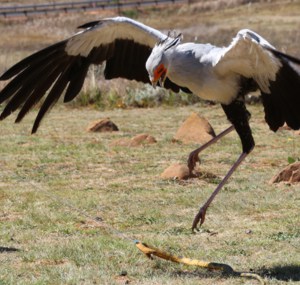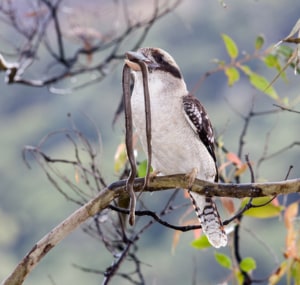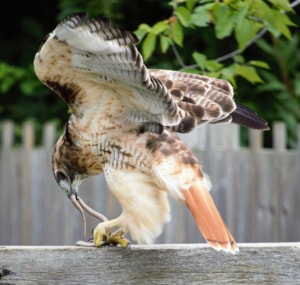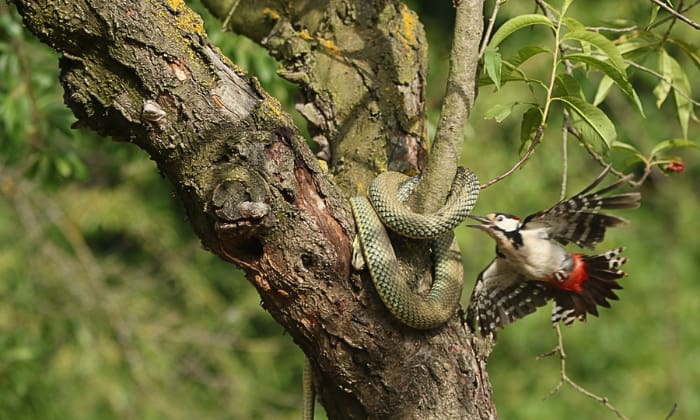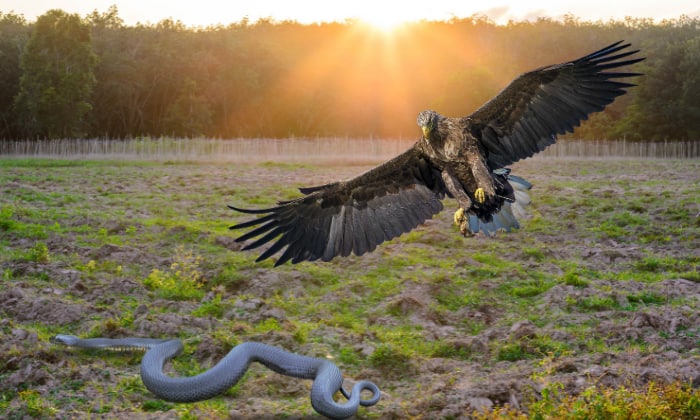Do birds eat snakes? Yes, several birds are considered predators of snakes. This particular type of hunting and feeding on snakes is called Ophiophagy which means “snake eating.”
So, what birds eat snakes? Birds of prey are one of the most common snake hunters, but you might be surprised to know that even small birds eat snakes. Medium-sized birds such as crows and even domestic birds such as chickens eat snakes as their meal.
Below is a list of birds that kill snakes. Get to know these snake-eating birds and learn valuable information about them by reading this article.
Table of Contents
List of Birds That Eat Snakes
1. Crested serpent eagle (Spilornis cheela)
The Crested Serpent Eagle is a native of the tropics and is found across the warmer regions of Asia. It is a medium to large-sized bird of prey with a wingspan as long as 2 feet 11 inches to nearly 6 ft. This bird has a stocky build, dark brown feathers, and a bare, yellow face.
It is named as such because of its propensity to hunt snakes. They are classified under the genus Circaetus along with other eagles that prey on reptiles.
They hunt and look for food in open woodlands, farm fields, and forest edges. They target snakes and reptiles such as lizards, but they also prey on other small mammals and insects.
2. Secretary bird (Sagittarius serpentarius)
This tall raptor stands at 4 feet tall and is endemic in the grasslands and bushlands of Sub-Saharan Africa. It is a terrestrial bird that kills snakes. It stays mostly on the ground, flying only when needed, such as during courtship and nesting.
The Secretary Bird is a large bird with long legs, white to gray feathers on the upper body, black feathers on the tip of the wings, and black legs. It has a distinctive orange face and a crest of black feathers crowning the head.
With its long legs and large build, it mainly hunts on foot and eats a variety of prey such as insects, rodents, birds, and reptiles, including snakes. Secretary birds eat poisonous snakes such as cobras and vipers.
3. Chicken (Gallus gallus domesticus)
This species of junglefowl is one of the most common domestic animals in the world. It originated in Southeast Asia and has spread worldwide across continents.
They are often kept as farm birds for their eggs and meat. Some are kept as pets, and the male chickens are popularly bred for cockfighting which may have a religious and cultural symbolism in countries in Southeast Asia and South America.
Chickens are omnivorous birds. Their diet is varied, which includes seeds, grains, and insects. They are capable of killing small animals such as lizards, mice, and even snakes.
4. Laughing kookaburra (Dacelo novaeguineae)
This medium-sized bird with a white head and brown feathers on the wings belongs to the Kingfisher family and is a native of Australia. Its common name reflects its call’s distinctiveness and uniqueness, which truly sounds like a hearty laugh.
It may look harmless, but it has an eye for many kinds of prey. They eat rodents, insects, fish, worms, mice, lizards, and snakes. They prefer to perch on trees and wait for any vulnerable prey to pass so they can snatch them with their talons.
5. Great horned owl (Bubo virginianus)
The Great Horned Owl is a large nocturnal bird of prey native and widely distributed across America. It is also called the tiger owl or the hoot owl.
This heavy-built owl is considered one of the heaviest owls in existence, ranking second only to the snowy old. The females are larger than the males, with an average body weight of 1,6 kg (3.5 pounds), while the males have a mean weight of 1,2 grams (2.6 pounds).
Owls are carnivorous birds, and the diet of the Great Horned Owl is no different from other birds of prey. Because of their powerfully built legs and talons, they can take on a range of animals, from small rodents, and lagomorphs, to other birds such as ducks.
Reptiles such as snakes are part of their diet. These birds eat rattlesnakes, particularly the venomous prairie rattlesnakes (Crotalus virdis), and have been cited for eating other large species, such as the common king snakes (Lampropeltis getula).
6. Red-tailed hawk (Buteo jamaicensis)
This species is one of the most common species of hawk found worldwide. Their large size identifies them, such as their characteristic red tail and the brownish-to-black bands on the leading edge of their wings.
It is rare to have sightings of them in your garden or residential areas, they are easily found in open habitats such as fields, forests, deserts, and grasslands, where hunting for small animals is their primary food source.
They habitually prey on mice, rats, rabbits, voles, and ground squirrels. Rodents take up 85% of their diet, but since they are opportunistic feeders, they also eat anything that comes across their way, including reptiles such as snakes.
The red-tailed hawk has been observed to eat both harmless and venomous types of snakes. Among the reptilian group, it has a preference for snakes, with 40 species recorded as having been part of this hawk’s diet. The most common species of snake that it is known to consume is the gopher snake (Pituophis catenifer).
They also prey on birds, including those from the corvid family, such as crows and ravens, and other species of passerine birds.
7. Other large birds
Other than that, you can also notice familiar bird species that catch and eat reptiles, including:
- Eagles – These birds prefer rattlesnakes and cottonmouths when catching the prey for their meal.
- Cranes – These elegant birds can hunt and eat snakes, mice, and frogs.
- Herons – We can encounter Herons feeding on snakes in the water, as it has a long leg and huge build to win over the slim prey.
Related: Top 10 Largest Birds of Prey on Earth
Reasons Why Birds Eat Snakes
There are several reasons why birds choose snakes as a part of their diet.
The most obvious one is that they are considered prey by these birds. It is not unusual to see a bird catching snakes, especially when the birds are known carnivores.
To cite some examples, birds of prey such as eagles and falcons eat snakes as part of their diet. Vultures eat snakes, especially dead or injured ones because their diet is primarily carrion. Small birds, such as robins, can also eat small snakes.
Another reason that birds eat snakes is out of defense or to protect their nest. Some birds don’t eat snakes as a regular part of their diet, but when a snake comes near them or threatens their young, these birds can act to kill and eat the snake. One example is the wild turkey which can kill a snake with its beak and sharp talons.
Frequently Asked Questions
Can birds eat venomous snakes?
Yes, birds can eat venomous snakes.
Examples of birds that eat venomous snakes are the red-tailed hawk, an opportunistic carnivore who eats anything that comes its way. To date, 15 species of venomous snakes have been documented in its diet. An example of this is the western rattlesnake.
Another example is the great horned owl that eats poisonous snakes such as cottonmouths and pit vipers such as the prairie rattlesnake.
What are the best birds to keep snakes away?
Guinea fowl is one the best birds to keep snakes away from your garden or property. These ground-nesting birds are social animals, live in flocks, and are low maintenance.
They are noisy and are quick to sound off when a snake is nearby, and this makes them ideal as a snake deterrent because snakes are sensitive to loud noise. Just allow them to roam freely, and they could protect your chickens from all kinds of predators, including snakes.
Do some snakes eat birds?
Yes, although most snakes do not catch mature birds as prey, some species eat birds during an opportunistic attack. Snakes also eat bird eggs and defenseless nestlings. Here is a list of some snakes that eat birds:
- Coachwhip – nonvenomous snake of the colubrid family that aggressively hunts small birds.
- Kingsnakes- this species of nonvenomous snake is native to North America and can grow to a length of 5 feet. Birds are part of their diet, along with lizards and other snakes.
- Rat snakes- rats are on top of this nonvenomous snake’s diet list but also eat birds.
Conclusion
The feeding habits of birds vary from one species to another. Snakes are a good source of protein for birds, so it is not surprising that some birds seek them out as their primary meal of choice.
Knowing what birds eat snakes is a knowledge one can keep for extra brownie points, and surely it may prove useful in the future when identifying different birds during your birding trips.
Share this article with friends or other bird enthusiasts if you found this article interesting and worth reading.

George and I became friends after a birdwatching trip with our new group. And we have been enjoying every adventure together. When he told me the idea of establishing a site that shares our experiences and fun, I immediately agreed. After trials and errors, here we have Thayerbirding.





